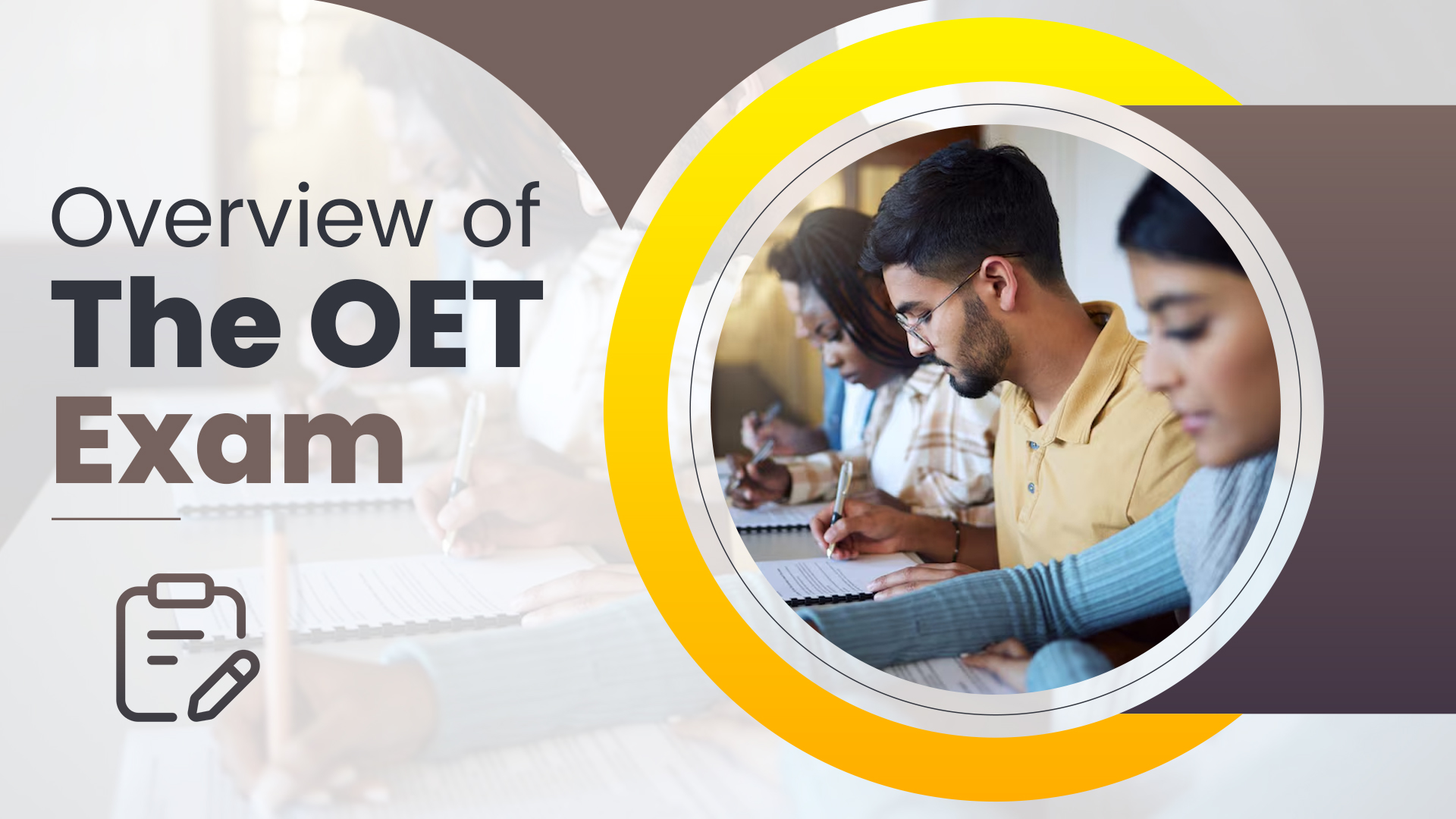What is the full form of OET?
OET stands for the Occupational English Test. It’s an international English language exam specially curated for overseas healthcare professionals looking to prove their proficiency in English. That includes pharmacists, nurses, doctors, dentists, physios, and others who need to prove their language proficiency to register or work in English-speaking countries. It’s not some generic test like IELTS or TOEFL. It’s built around actual workplace tasks.
Think of it this way:
- You’re not writing essays on climate change.
- You’re not being asked to interpret obscure poetry.
Instead…
- You’re being asked to complete tasks like:
- Writing a referral letter about a diabetic patient
- Explaining a drug dosage to a confused patient
- Understanding a clinical handover recording
Why do healthcare professionals prefer OET over other exams?
Here’s what many candidates say (and we’ve heard this again and again):
“It just feels more familiar. Less like an exam, more like my actual job.”
Your assessment will be based on how well you can communicate clearly, accurately, and professionally. Grammar and vocabulary do matter, no matter which English proficiency test you are appearing for. But they’re assessed within real clinical conversations.
Who can take the OET?
If you work in any of these 12 healthcare professions, the OET is tailored for you:
- Medicine
- Pharmacy
- Nursing
- Dentistry
- Physiotherapy
- Radiography
- Occupational Therapy
- Optometry
- Dietetics
- Speech Pathology
- Podiatry
- Veterinary Science
OET test materials are adjusted to each profession. So, a pharmacist won’t get the same writing task as a nurse or doctor. The speaking roleplays? Also profession-specific.
Where is OET accepted now?
Here’s where OET is officially recognised for licensing, registration, and sometimes even visa purposes:
| Country | Who Accepts it |
| Australia | AHPRA (All Boards), Immigration, and Employers |
| UK | GMC, NMC, GPhC, NHS trusts |
| Canada | PEBC (Pharmacy), Some Nursing Colleges |
| New Zealand | Medical, Nursing, and Allied Health Councils |
| Ireland | NMBI, CORU, and others |
| USA | ECFMG (for doctors, limited use) |
Please Note: Always double-check with the body you’re applying to. Not all accept all formats or allow “clubbing” of scores.

How does the OET differ from IELTS or TOEFL?
| Feature | OET | IELTS/TOEFL |
| Designed for? | Healthcare Professionals | General / Academic use |
| Writing Tasks | Referral / Transfer Letters | Essays |
| Speaking Format | Roleplays with healthcare focus | General Q&A / topics |
| Listening Tasks | Consultations / Clinical Talks | Lectures / Dialogues |
| Recognition | Healthcare Licensing Bodies | Academic Institutions & Visa |
Is the OET easier than IELTS?
OET is definitely much easier than IELTS in terms of profession of people appearing for it. If you’re already in the healthcare world, OET may feel easier because of its familiar context. But you still need strong English skills. In OET, you’ll be assessed not only on language but also clarity, tone, accuracy, and the ability to extract relevant information quickly.
Structure of the OET exam
If you're planning to take the OET this year, you’ll want a solid understanding of how the exam is actually laid out. This section breaks down all four parts of the test, what to expect in each, and how they’re marked, using the updated guidelines.
Think of this as your behind-the-scenes tour.
1. Listening Sub-Test
Duration: ~40 minutes
Parts: 3
Total questions: 42
What you’ll be asked to do:
- Part A – Listen to two consultations between a healthcare professional and a patient, and fill in notes.
- Part B – Listen to short workplace extracts (handover, briefings) and choose the correct answer.
- Part C – Listen to presentations or interviews with health professionals and answer multiple-choice questions.
Accents you might hear:
You’ll hear a mix of British, Australian, American, Irish, and other English-speaking accents. This reflects how healthcare is truly global now.
Scoring pattern:
- Part A: 24 marks
- Part B: 6 marks
- Part C: 12 marks
Top tip: In Part A, your spelling and grammar do count. And you must write down exactly what the patient or professional says, no rewording or “interpreting.”
Common pitfall: Some candidates lose marks by adding extra information or paraphrasing. Don’t! Just write what you hear.
2. Reading Sub-Test
Duration: 60 minutes
Parts: 3
Total questions: 42
How it works:
- Part A – Four short texts on a single healthcare topic. You have 15 minutes to answer 20 questions.
- Part B & C – Longer texts followed by multiple-choice questions.
Scoring breakdown:
- Part A: 20 marks
- Part B: 6 marks
- Part C: 16 marks
Watch out for:
- Spelling matters. Incorrectly spelled answers in Part A won’t get you marks.
- Time management is key. You won’t get extra time to check answers later.
3. Writing Sub-Test
Duration: 45 minutes
Task: Write a profession-specific letter using case notes.
What you’ll do:
You’ll be given:
- A brief background
- A set of patient case notes
- A writing task (usually a referral, discharge, or transfer letter)
You’ll need to write a clear, professional letter using the right tone, structure, and vocabulary for your role.
Who marks it:
Two trained OET assessors, using six key criteria:
- Purpose
- Content
- Conciseness & Clarity
- Genre & Style
- Organisation & Layout
- Language (spelling, grammar, vocabulary)
What not to do:
- Don’t dump the entire case history into your letter. Pick what’s relevant.
- Don’t ignore tone. You’re writing to another healthcare professional, not a friend.
4. Speaking Sub-Test
Duration: ~20 minutes
Structure: 2 role-plays (5 minutes each)
Prep Time: 3 minutes per role-play
What happens:
You’ll play the role of a healthcare professional (e.g. pharmacist), and the interlocutor plays a patient or colleague. You'll be given a scenario to act out based on your profession. It might be something like explaining a medication schedule, handling a patient’s concern, or clarifying a side effect.
How it’s assessed:
Your speaking will be evaluated across two main categories:
- Linguistic criteria – fluency, pronunciation, grammar, vocabulary
- Clinical communication – how well you explain, reassure, ask questions, and show empathy
Can you write on the role-play cards?
Yes. You can make notes, but you have to return the card after the test.

OET on Paper, Computer, or at Home: Here’s What You Need to Know
Back in the day, OET was a paper-only exam. But a lot has changed—especially after the pandemic accelerated remote testing. Now, candidates have more options than ever.
In 2025, you can take the OET in one of three formats:
- OET on Paper (the original version)
- OET on Computer (at a test centre)
- OET@Home (remotely from your own device)
Each one is the same test in terms of difficulty, question type, and scoring. The difference lies in how, where, and when you take it.
Let’s unpack each.
OET on Paper (Traditional, But Reliable)
This is the format most healthcare professionals are familiar with. You show up at a test centre, write your answers by hand, and do your speaking test in person.
Availability: Usually offered once or twice a month: Fridays in the Americas, Saturdays worldwide.
Test components:
- Listening, Reading, and Writing are done on paper.
- Speaking is done face-to-face at the test centre.
Good for you if:
- You’re more comfortable writing by hand.
- You’re not tech-savvy and don’t want to deal with screens.
- You want the classic test-day experience.
Watch out for:
- Limited test dates. You’ll need to plan ahead.
- Slightly slower results turnaround (around 17 days).
OET on Computer (Test Centre, Digital Format)
This version is taken at an official test venue, but on a computer.
Availability: Offered almost daily: Monday through Saturday at selected centres.
Test components:
- Listening, Reading, and Writing on a computer.
- Speaking is done separately via Zoom (usually a few days before or after the written sections).
Good for you if:
- You type faster than you write.
- You want quicker access to test dates.
- You don’t want to travel far for the speaking section
Watch out for:
- You must complete all sub-tests within the same test administration window, usually 5–8 days.
- If you miss your Speaking slot, you’ll get a zero score and need to rebook.
OET@Home (Remote testing from your home)
OET@Home was launched to offer flexibility for candidates who can’t travel to a venue. It’s proctored online and includes identity checks, camera monitoring, and screen locking.
Availability: Available six days a week, Monday through Saturday.
Test components:
- Listening, Reading, and Writing via a secure browser.
- Speaking via Zoom, within the same test window.
Good for you if:
- You don’t live near a test centre.
- You’re applying from a remote region or need special testing conditions.
- You prefer a quiet home environment (and meet tech requirements).
Watch out for:
- Strict system checks: You’ll need a stable internet connection, a working webcam, and a quiet test environment.
- If your ID doesn't match what you booked with or your tech fails mid-test, you risk disqualification or score delays.
Please note, OET@Home is available only for select professions: Medicine, Nursing, Pharmacy, and Physiotherapy.
Pharmacists, take note:
All three options: paper, computer, and at home, are open to pharmacy professionals as of 2025. However, make sure your regulatory body accepts the test mode you're choosing.
For example:
- PEBC (Canada) may have preferences.
- AHPRA (Australia) accepts all formats.
- The UK’s GPhC accepts computer-delivered and paper-based OET.
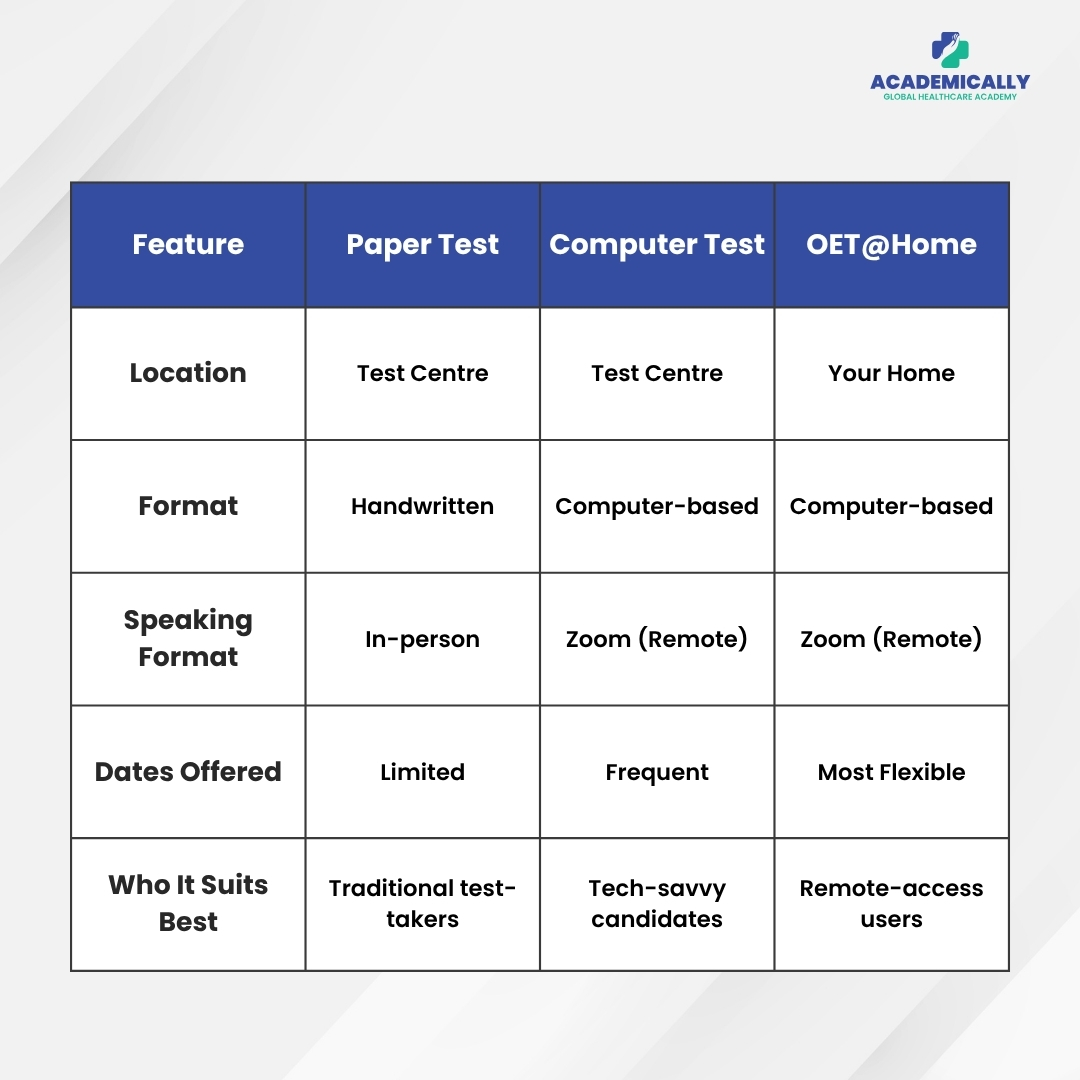
How to choose the right format
Ask yourself:
- Can I trust my internet and power connection?
- Am I better at typing or handwriting?
- Do I need more flexible dates?
- Will my chosen healthcare board accept my test mode?
Once you answer these honestly, the right format usually becomes obvious.
Pro tip: If you’re not sure, go for the Computer test at a venue. It gives you the best of both worlds: structure + convenience, with fewer risks than OET@Home.
How to Book Your OET in 2025: Easy to Follow Steps
You’d be surprised how many healthcare professionals mess up the OET booking process, even smart ones. The good news? You don’t have to be one of them.
This section walks you through the step-by-step booking process, the documents you need, ID rules to avoid rejections, and how “clubbing” your scores works (in case you need to retake any sub-test).
Whether you choose OET on Paper, Computer, or @Home, booking always starts online.
Step 1: Create your OET account
If you’re applying to ECFMG (for US medical registration), use the same email as your ECFMG account.
Step 2: Choose your test mode and date
- Select Paper, Computer, or OET@Home.
- Pick your profession (Pharmacy, Nursing, Medicine, etc.)
- Choose your country and venue (if needed).
- Select a test date (based on availability).
Step 3: Upload your valid ID
Accepted ID types (must not be expired):
- Passport (Preferred)
- National Government-issued ID (with your photo, full name, and date of birth)
- No driver's licenses allowed (even in the UK or US).
- If your ID isn’t in English, you’ll need a certified translation.
Step 4: Make the payment
- As of 2025, the full test costs AUD 587 (roughly ₹32,500 or $395 USD, depending on currency).
- Pay via credit/debit card.
- You’ll receive a confirmation email + invoice after booking.
Step 5: Wait for the final test timetable
- For Paper: Timetable is emailed 48 hours before the test.
- For Computer/@Home: You’ll also get a Zoom link (for the Speaking test) by email.
ID Rules You Must Know in 2025
Many candidates are turned away on test day simply because their ID doesn’t match.
Here’s what to double-check:
| Requirement | Common Mistakes |
| ID must be valid and not expired | Using an old passport |
| Must match booking details | Spelling mistakes in your name |
| Must be uploaded clearly | Blurry or cropped photo |
| No driver’s license | Bringing driver’s license in the UK |
New rule (2025): E-Visas are NOT accepted as ID documents. If your BRP (UK) is expired, bring a secondary valid ID or apply for an authorisation letter in advance.
What if you’re a Refugee or Asylum seeker?
If you don’t have a passport or national ID, you may still be allowed to book the OET.
In the UK, you can use:
- Biometric Residence Permit (BRP)
- Application Registration Card (ARC)
- UK Home Office travel document
- Official immigration or refugee documents with your name, photo, and date of birth.
- You must also submit an authorisation letter request within 48 hours of booking.
What is “Clubbing” and can you use it?
Clubbing means combining the scores of two different test sittings to meet the requirements of a regulatory body.
How it works
Let’s say you scored well in Listening and Speaking in January, but didn’t get the required marks in Reading and Writing. You can reappear and combine the new scores (if both results are within a 6-month window).
But here’s the catch. Not all organisations accept clubbing.
| Country | Accepts Clubbing? |
| Australia (AHPRA) | Yes (2 sittings within 6 months) |
| UK (NMC/GPhC) | Yes, for most cases |
| Canada (PEBC) | No, single sitting only |
| USA (ECFMG) | Not applicable |
Please note: Always check the official website of your healthcare board before relying on clubbing.
What if you don’t show up on test day?
Life happens. But if you miss your test without a valid reason, here’s what you’re looking at:
- No refund
- No transfer
- 0 score recorded
However, if you had a genuine emergency (like a health issue or family crisis), contact OET Support within 5 business days. They might allow rescheduling or partial refund, but only if you submit documents.
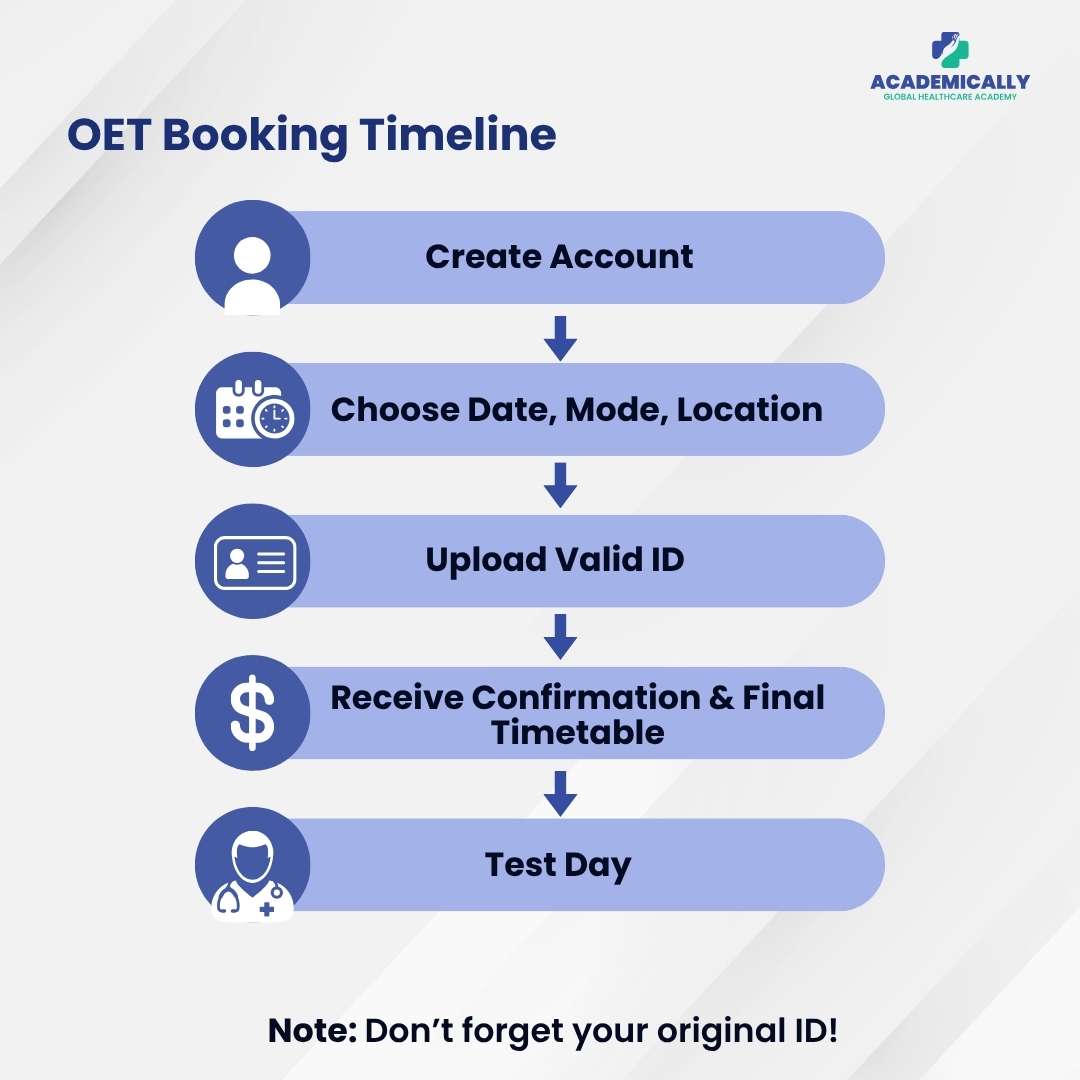
OET Scoring System in 2025: What’s a Good Score, Really?
There are four sub-tests: Listening, Reading, Writing, and Speaking.
Each sub-test is scored individually, on a scale from 0 to 500. You don’t get an overall “average” score like IELTS or TOEFL. What matters is how you perform in each section.
| Score (0–500) | Grade | What It Means |
| 450–500 | A | Very high level of performance. You can communicate fluently and precisely in a healthcare setting. |
| 350–440 | B | You can handle effective communication in healthcare. Some minor errors are okay. |
| 300–340 | C+ | Communication might sometimes break down. Not enough for registration in most countries. |
| 200–290 | C | Too many errors. Likely to cause confusion in a clinical setting. |
| Below 200 | D/E | Communication breakdown. You’ll need serious improvement. |
What score do you need?
This depends entirely on your profession and the country you're applying to. Let’s look at a few examples:
Pharmacists
| Country | Minimum Score |
| Australia (AHPRA, Pharmacy Board) | 350 in each sub-test |
| UK (GPhC) | 350 in all 4 sections in one sitting |
| Canada (PEBC) | 350 in each; must be in one sitting, no clubbing |
| New Zealand | 350 in each sub-test |
| Ireland | 350 or above; some accept C+ in one section with conditions |
Pro Tip: Always aim for at least B grade (350+) in every sub-test. Some regulators may allow a single C+ if your overall communication is strong, but don’t bet on it.
What’s Considered a “Good Score” for Pharmacists in OET?
Short answer: Aim for 4 B’s (i.e. 350 in all sub-tests)
This keeps your options open whether you apply to the UK, Australia, New Zealand, or Ireland. Even Canada won’t be a problem if you meet this.
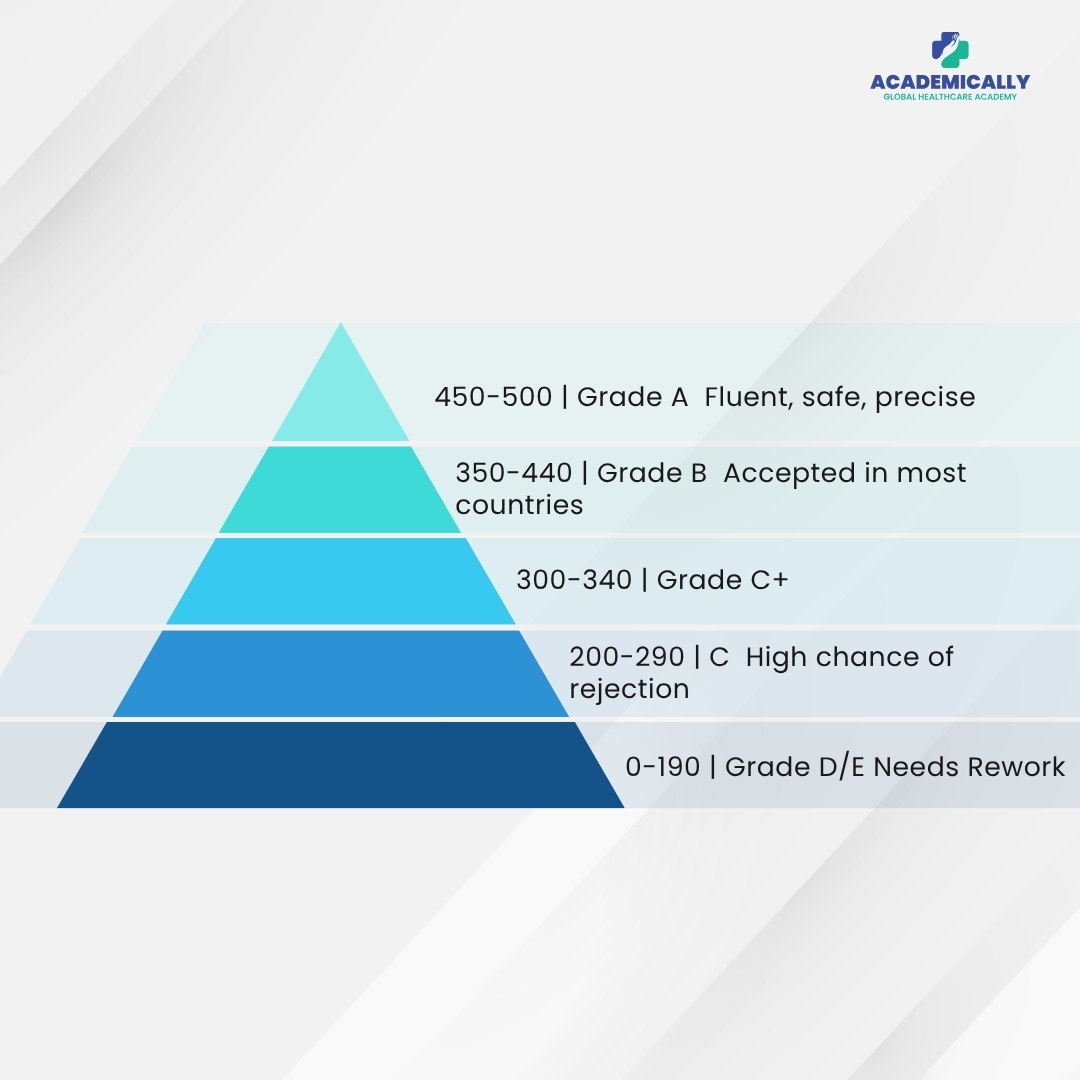
OET Test Day in 2025: What to Expect, What to Bring & What to Avoid
So you’ve booked your test, practiced your roleplays, reviewed your case notes, and you’re feeling ready. Now comes the real deal: test day.
Let’s walk you through what actually happens on the day of your OET. Whether you're doing it on paper, on a computer, or at home, we’ll also cover what to carry, what not to do, and some awkward mistakes you’ll want to avoid.
1. Arriving at the Test Centre (Paper & Computer)
For Paper Test:
- Arrive at least 30-45 minutes early.
- You’ll get your Listening, Reading, and Writing sub-tests done in one sitting.
- Speaking usually happens later the same day or the day before/after, depending on your slot.
For Computer Test at a Centre:
- Show up at least 30 minutes before your start time.
- The Speaking sub-test is done via Zoom, usually a few days before or after.
Remember: Don't wait for a reminder SMS. Check your email (including spam) for the final test timetable from your venue usually sent 48 hours prior.
2. Taking OET@Home: English Proficiency Test from the comfort of your home
If you’re testing from home:
- You need to log in 15 minutes early via Prometric’s secure platform.
- The system will check your ID, camera, microphone, and surroundings.
- You must be alone in a room with no interruptions.
Please note, Even minor noises (like a knock at the door or someone walking behind you) can lead to disqualification. Take this seriously.
Also:
- Don’t wear headphones during Speaking.
- Make sure your device has all software updated (Zoom, ProProctor).
- Clear your desk. Nothing should be in view except water (in a clear bottle), your ID, and pre-approved medical items if needed.
3. ID Rules for verification
Your original ID must match what you uploaded during booking.
Make sure it’s:
- Not expired
- Legible (no faded print or peeling lamination)
- The same name and spelling you used to register
Bring one of these:
- Passport (strongly recommended)
- National ID (must include your name, photo, and date of birth)
Not accepted:
- Driver’s license
- College or hospital ID cards
- Screenshots or photocopies
Please remember, If there’s a mismatch, you may still be allowed to test, but your results can be withheld while they verify your identity.
4. What you’re allowed to carry (and what you’re not)
Allowed in the test room:
- Original ID
- Pens, pencils, erasers (non-mechanical only)
- Small clear water bottle
- Pre-approved snacks or medication
- Your test-day timetable (optional)
Not allowed:
- Phones (must be turned off and stored away)
- Smartwatches or any wearable tech
- Notes, study materials, dictionaries
- Bags, books, highlighters, correction pens, sticky notes
- Jackets, scarves, or sunglasses worn indoors
All your belongings will go into a cloakroom or locker.
5. During the test – What to keep in mind
- You’ll be monitored the entire time via invigilator (at the centre) or proctor (online).
- Raise your hand if you need help or a bathroom break. Don’t speak to other candidates.
- You’ll be asked to stop immediately when time’s up. Keep writing after that, and your paper may be disqualified.
- No chewing gum, no fidgeting, no whispering.
- If you’re taking breaks or leaving the room, you’ll need permission and may have to go through another ID check.
6. Speaking Sub-Test – Quick Pointers
For Paper test:
- Done face-to-face with an interlocutor at the venue
- You’ll be given a card and 3 minutes to prepare for each roleplay
- Then you speak for 5 minutes (2 roleplays total)
For Computer/@Home test:
- Speaking is done via Zoom
- You’ll receive a separate email with your meeting link and schedule
- Log in 10 minutes before your scheduled time
- Have your ID ready to hold up to the camera
Top Tip: Speaking tests are recorded for scoring. Be natural, but focused. The assessors aren’t looking for perfection. They want clarity, empathy, and confidence.
7. What If You Feel Sick or Panic on Test Day?
If you're unwell or something urgent comes up:
- Before the test starts: Speak to staff. You may be able to defer.
- After the test has started: You can’t cancel or defer. You must complete it, or it’ll count as a no-show.
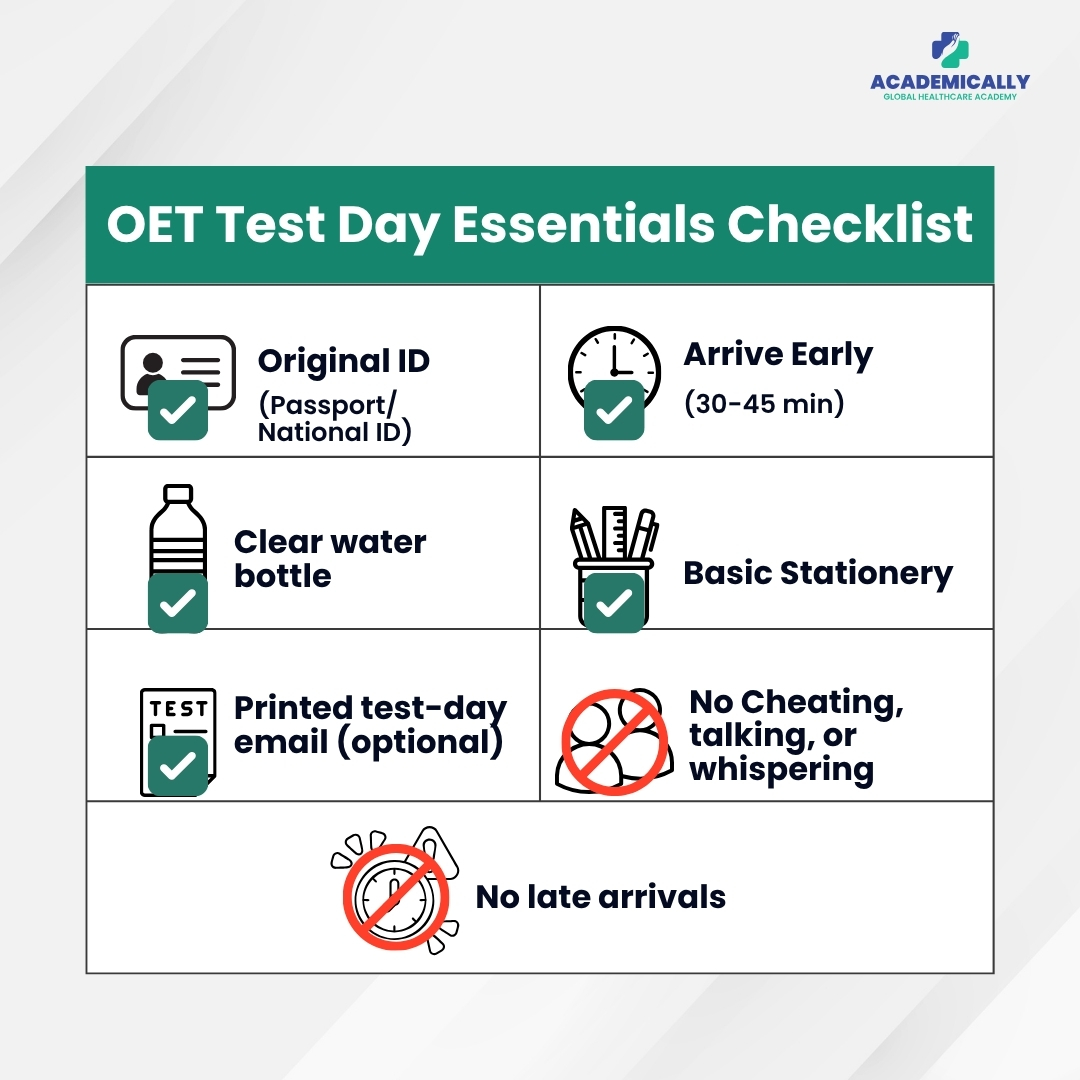
Don’t force yourself through the test if you’re seriously unwell, you’ll perform poorly, and it won’t help your chances.
How to Prepare for the OET in 2025: Smart Strategies & Real Tips That Actually Work
Let’s face it, preparing for OET isn’t just about brushing up your English. It’s about learning how to communicate like a healthcare professional in English.
And here’s the thing: most healthcare workers already speak English decently. What trips people up is tone, clarity, and structure, especially in writing and speaking.
So how do you actually prepare in a way that feels useful, efficient, and not robotic?
This section walks you through genuine study methods, online tools that are worth it, and mistakes to avoid as a pharmacist or healthcare candidate.
1. Build Real-World English, Not Exam-English
If your prep consists of memorizing grammar rules or vocabulary flashcards… stop. That’s not what OET is testing.
You should focus on:
- Clinical tone and register – knowing when to be formal vs empathetic
- Clear writing flow – especially when writing referral letters
- Listening for keywords and context clues – the kind used in consultations
- Speaking to calm, reassure, or explain – just like real practice
Remember, You're being tested on your ability to work safely in an English-speaking clinical setting, not just language accuracy.
2. Consider Coaching (Only If It’s Targeted)
You don’t need to spend thousands on OET preparation. But if you're struggling with writing or speaking, even a few personalised sessions can make a massive difference.
What good coaching should include:
- Feedback on your own writing samples, not just model answers
- Roleplay practice tailored to your profession (e.g. pharmacist, nurse)
- Understanding what examiners want in each criterion
- Updated practice material based on 2025 changes
Academically’s OET preparation course has been opted by many healthcare professionals migrating from their home country to abroad. They have expert-led sessions, AI-powered mock tests, question banks, community support and lots more.
3. Practice Profession-Specific Materials
Make sure your practice materials match your profession.
For example:
- A pharmacist’s writing task might be a letter to a doctor requesting repeat prescription advice
- A nurse might write a transfer letter to a rehab facility
Using the wrong roleplay or writing samples wastes time and builds bad habits.
Where to find real samples:
- Official OET Website
- Sample packs for your profession (PDFs)
- Reputed coaching platforms like Academically with AI-based mock tests, downloadable PDF handouts, etc.
Top Tip: Look for 2024 or 2025 versions: older material won’t match the tone or structure expected now.
4. Improve Listening Without Studying
Want a low-effort way to boost your listening? Replace your background music with:
- Medical podcasts
- YouTube patient interviews, GP consultations, or TED Talks on health topics
- Australian or UK health vlogs – accents matter in OET Listening
Listen passively while doing chores, commuting, or exercising. You’ll absorb tone, pacing, and how professionals speak in real scenarios.
5. Write Letters Every Week
You get better at writing letters… by writing letters. Not by reading about them.
Here’s a weekly routine that works:
| Day | Task |
| Monday | Read 1 sample writing task (your profession) |
| Tuesday | Attempt it without timing |
| Wednesday | Review + compare with model answer |
| Thursday | Rewrite with corrections |
| Friday | Try again with 45-minute limit |
| Saturday | Get feedback (if possible) |
| Sunday | Break or revise vocabulary phrases |
6. Practice Speaking – But Ditch the Script
Here’s what most OET candidates do:
They memorise entire roleplay dialogues and hope the real exam matches.
That doesn’t work.
Instead:
- Learn structures (e.g. opening the conversation, summarising, checking understanding)
- Use roleplay cards with a friend or teacher
- Record yourself and assess for clarity, confidence, and natural tone
- Practice sounding calm and reassuring—even under pressure
Know that, You’re not graded on how fast or fancy you speak. You’re graded on whether a patient would trust you after that conversation.
Bonus Tip: Learn Examiner Lingo
Understand the exact words examiners look for in the OET assessment criteria.
For example:
- “Purpose” (Writing): Did your letter have a clear, relevant reason from the start?
- “Appropriateness of Language” (Speaking): Were your words suitable for the patient’s understanding?
When you learn to “think like an examiner,” you naturally start scoring higher.
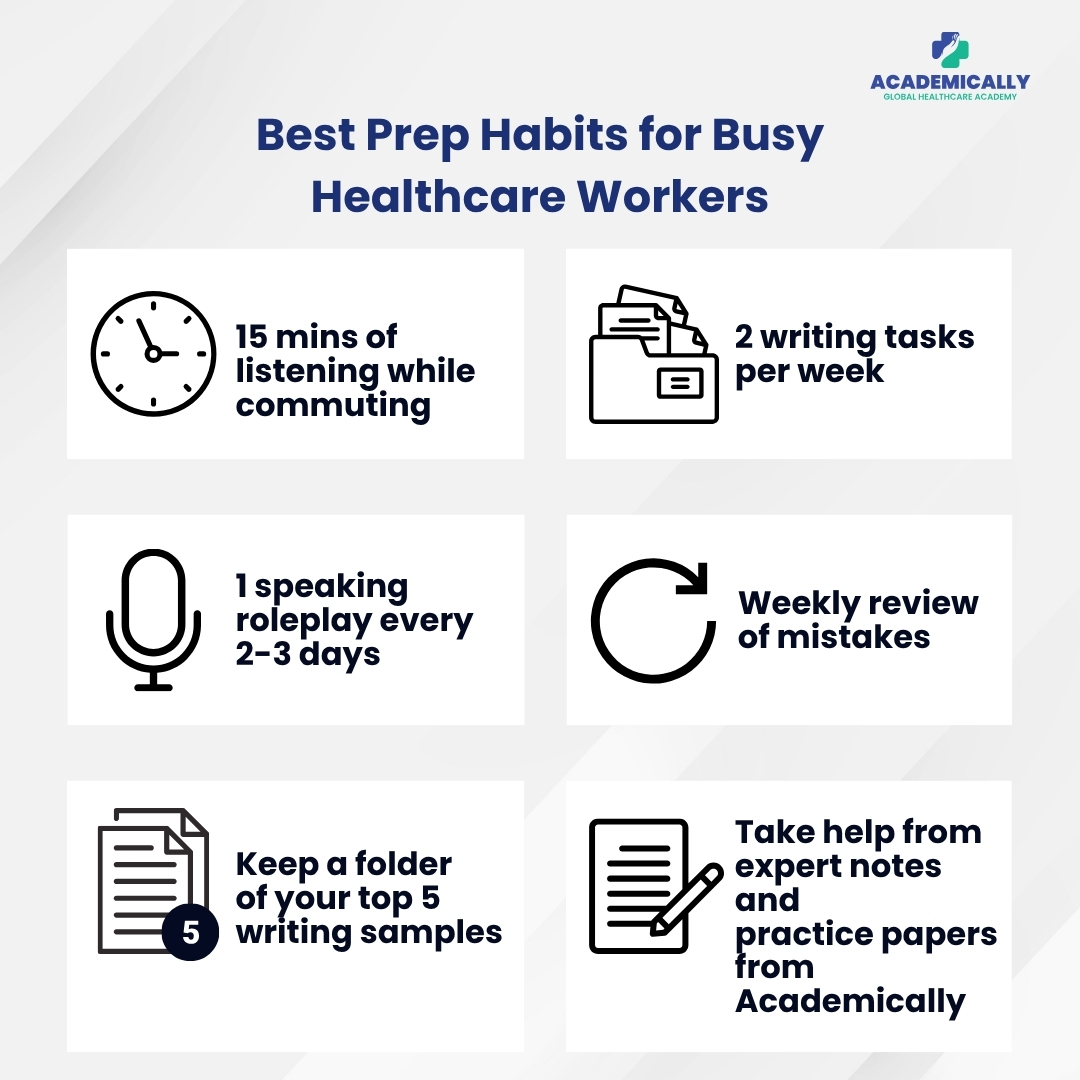
After the OET: Results, Re-marking, and What Comes Next (2025)
You’ve completed your OET. Your pen is down, your Zoom tab is closed, and you’re probably feeling a weird mix of relief and nervousness. Now what?
Here’s what typically happens next, from receiving your results to what to do if you didn’t get the score you needed, and how to move forward with registration or retesting.
When will you get your OET results?
Your results will be released around 10 to 12 business days after your test day (including Speaking). You’ll receive an email notification when they’re ready.
Where to check:
Did you know… For OET@Home and Computer tests, your result may come slightly sooner than for paper-based tests.
How are results delivered to registration boards?
If you're applying to:
- AHPRA (Australia)
- NMC / GPhC / GMC (UK)
- PEBC (Canada)
- CORU (Ireland)
You may need to send results directly from OET to the authority via your portal. Some regulators can verify results online, while others need you to upload a certified PDF.
Didn’t Get the Score You Wanted? Here’s What You Can Do
Let’s say your scores came back, and you fell short in one or two sub-tests. Frustrating? Yes. End of the road? Definitely not.
You now have three options:
1. Apply for a Re-mark (if you believe it was unfair)
- Only available for Writing and Speaking
- Must be requested within 5 calendar days of receiving your result
- Costs AUD 120 per sub-test
- If your score is increased after re-marking, you get a full refund
Note: If you were very close to 350 (e.g. scored 340), and you’re confident, this might be worth a shot.
2. Book a Re-test (Full or Partial)
- You can re-sit just 1–3 sub-tests if you took the Paper test
- If you took OET on Computer or @Home, you’ll need to retake the entire exam
- Make sure your scores still fall within clubbing policy (if your regulator allows it)
Example: If you got 370 in Listening, 360 in Speaking, 330 in Writing, and 300 in Reading, you could retake only Reading and Writing, provided it’s within 6 months and clubbing is allowed.
3. Reassess and Rebuild Your Strategy
Maybe it’s not just about one unlucky day. If you’ve tried the OET 2–3 times and keep missing the mark in the same area (like Writing), it may be time to:
- Work with a professional trainer
- Get your writing scored with real examiner feedback
- Practice under timed conditions
- Understand how the OET criteria are applied to your specific profession
How Many Times Can You Take the OET?
There’s no official limit on how many times you can attempt the OET. But each attempt costs money and time, so it’s worth preparing thoroughly rather than repeating blindly.
Expert advice: Only rebook once you’ve had proper feedback on your weak areas. Otherwise, you’re just paying to guess.
What Happens If You Pass? Next Steps
If you scored 350 or above in all four sub-tests and meet your registration board’s rules, congratulations! Here’s what to do next:
- Download your Statement of Results PDF
- Submit it to the appropriate regulatory body
- Wait for verification or follow any extra instructions they send
- Complete your application for registration, licensing, or job processing
Did you know… For most pharmacists and nurses, OET is one of the last hurdles before official registration.
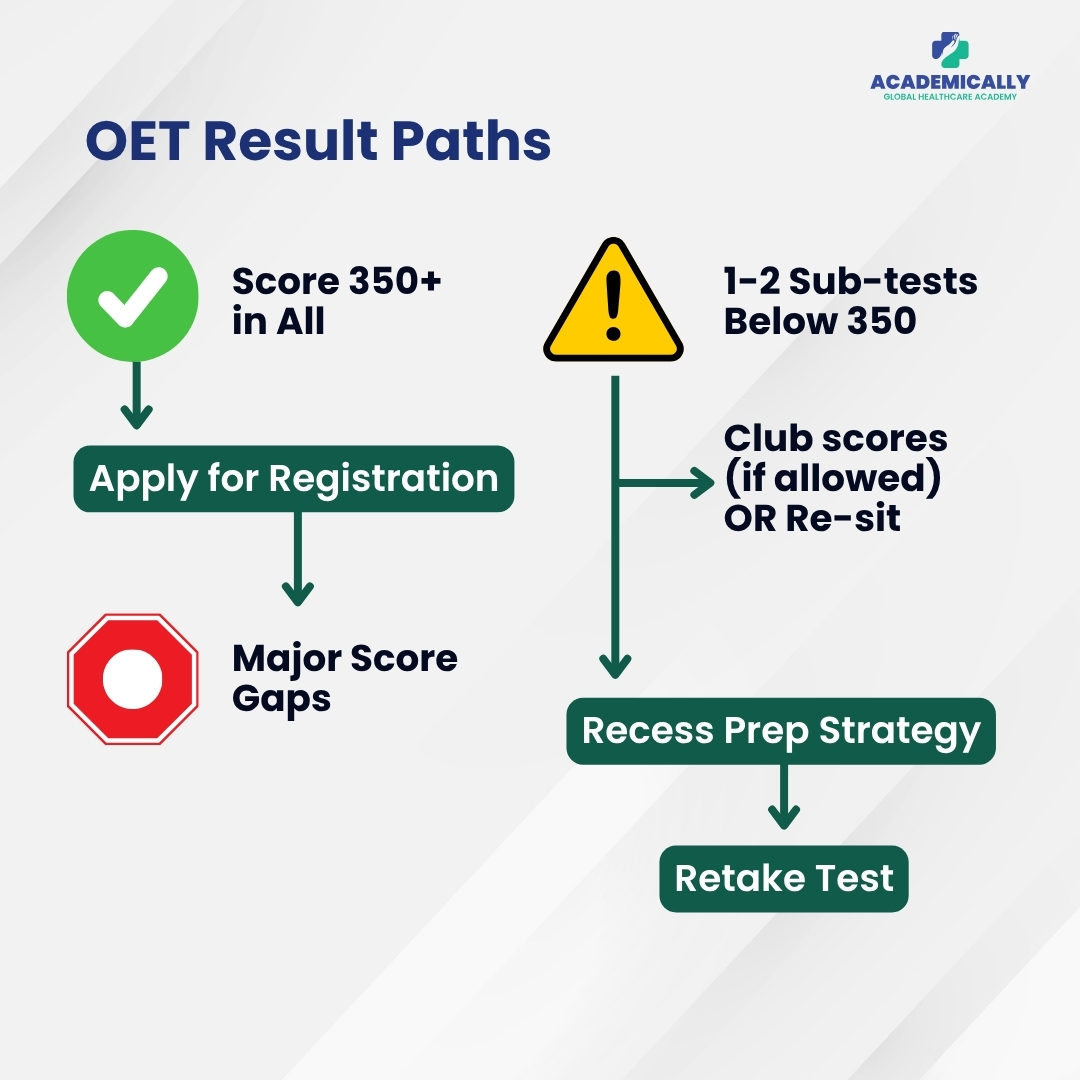
Final Tip: Save Your OET Results Securely
You may need them again for:
- Work visa applications
- Permanent residency
- Employer verification
- Job interviews or locum roles
So back up the PDF in at least two places, Google Drive, email, and/or a secure hard drive.
Need help after your OET result?
To Conclude with…
The OET exam isn’t just an English test, it’s your bridge to a global healthcare career. Whether you're a pharmacist, nurse, doctor, or allied health professional, OET prepares you to communicate confidently and safely in real-world clinical settings. With flexible formats, profession-specific tasks, and wide recognition across countries like the UK, Australia, Canada, and Ireland, it's the test that works for healthcare workers, not against them. Take time to prepare smartly, understand the format deeply, and walk into your exam day with clarity and confidence. Your international healthcare dream is closer than you think, start your OET journey today.
